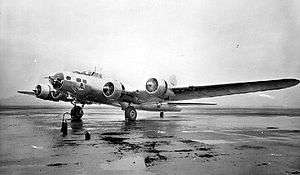Boeing C-108 Flying Fortress
C-108 Flying Fortress was the designation of four United States B-17 Flying Fortress heavy bombers which were converted to transport aircraft during World War II.
| C-108 Flying Fortress | |
|---|---|
 | |
| The XC-108 running up | |
| Role | Military transport aircraft |
| Manufacturer | Boeing / Lockheed-Vega / Wright-Patterson AFB |
| First flight | 1943 |
| Introduction | 1943 |
| Retired | 1945 |
| Primary user | United States Army Air Forces |
| Number built | 4 conversions from B-17 |
| Developed from | Boeing B-17 Flying Fortress |
Design and development
The first C-108 built (designated XC-108) was a B-17E (41-2593) converted to a V.I.P. transport for General Douglas MacArthur in 1943. With the exception of the nose and tail turrets, all armament was removed, as was all armor. The interior of the plane was made into a flying office for MacArthur, with extra windows, cooking facilities, and living space. To facilitate entry and exit, a drop-down door with steps was installed in the rear fuselage. A similar conversion was later made on a B-17F-40-VE (42-6036), which was redesignated YC-108.
Between August 1943 and March 1944, another B-17E (41-2595) was converted to a cargo aircraft and designated XC-108A. Hoping to convert obsolete bombers into cargo aircraft, the United States Army Air Forces initiated a remanufacturing station at Wright-Patterson Air Force Base. The plane was stripped of armament, armor, and other military equipment. Crew locations were shifted, and the nose was modified to provide space for cargo and/or personnel. The cockpit was accessed via the crawlway under it or through the hinged solid nose cone that had replaced the original glazed bombardier station. To increase cargo space, several bulkheads were removed and the bomb bay doors were sealed closed. This allowed much of the fuselage volume to be used to carry cargo or personnel.
A B-17F 42-30190 was converted (and given designation XC-108B) to tanker service. As in the XC-108A, it was devoid of armor and weapons, and the fuselage was modified to make space for its cargo. The fuselage was filled with fuel tanks.
Operational history
.jpg)
The XC-108 was personal VIP transport aircraft of General Douglas MacArthur in 1943.
The XC-108A was used to fly material and personnel over the Himalayas to the B-29 base in Chengdu, China. Due to chronic engine difficulties, it proved an impractical cargo aircraft. In October 1944, it was returned to the United States. By the end of the war, it was disassembled and left in a junkyard in Maine, where it suffered from some parts being scrapped and others salvaged from the airframe. Since then it has been rescued and is under restoration back to B-17E configuration.[1]
Variants
.jpg)
- XC-108
- B-17E converted to VIP transport standard for General Douglas MacArthur.
- YC-108
- B-17F converted to VIP transport standard for General Douglas MacArthur.
- XC-108A
- B-17E converted to cargo or troop transport standard.
- XC-108B
- B-17F converted for service as a tanker.
Two other cargo transports and VIP transports were made from the B-17.
- CB-17G
- Troop transport version capable of carrying up to 64 troops, 25 built.
- VB-17G
- VIP transport version for high level staff officers, 8 built.
Specifications (XC-108)
General characteristics
- Crew: 5
- Length: 74 ft 4 in (22.66 m)
- Wingspan: 103 ft 10 in (31.65 m)
- Height: 19 ft 1 in (5.82 m)
- Wing area: 1,527 sq ft (141.9 m2)
- Powerplant: 4 × Wright R-1820-65 9-cyl. turbo-charged air-cooled radial piston engines, 1,200 hp (890 kW) each
Performance
- Maximum speed: 260 kn (300 mph, 480 km/h)
Armament
- Guns: 4 × 0.5 in (13 mm) M2 Browning machine guns in nose and tail turret
Survivors
- XC-108A, 41-2595, "Desert Rat", survived in a New England junkyard and is being restored in 2011 in McHenry County, Illinois, by a private individual to B-17E configuration.[2]
See also
- B-17 Flying Fortress variants
Related development
- B-17 Flying Fortress
- XB-38 Flying Fortress
- YB-40 Flying Fortress
Aircraft of comparable role, configuration and era
- C-87 Liberator Express
Related lists
References
- "Aero Vintage Books: B-17E Desert Rat History". www.aerovintage.com. Retrieved 27 April 2018.
- "Aero Vintage Books: B-17 Locator". aerovintage.com. Archived from the original on 17 May 2015. Retrieved 27 April 2018.
- Jablonski, Edward. Flying Fortress. Doubleday, 1965. (ISBN 0-385-03855-0)
- Wagner, Ray. American Combat Planes. Doubleday, 1982. (ISBN 0-930083-17-2)
- Encyclopedia of American Aircraft
- USAF Museum
- Andrade, John M. . U.S Military Aircraft Designations and Serials since 1909. Leicester : Midland Counties Publications, First edition 1979. ISBN 0 904597 22 9.
External links
| Wikimedia Commons has media related to Boeing XC-108. |